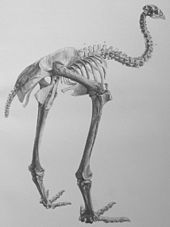モア
表示
(モア科から転送)
| モア | |||||||||||||||||||||
|---|---|---|---|---|---|---|---|---|---|---|---|---|---|---|---|---|---|---|---|---|---|
 ハーストイーグルに襲われる姿の復元模型
| |||||||||||||||||||||
| 分類 | |||||||||||||||||||||
| |||||||||||||||||||||
| 英名 | |||||||||||||||||||||
| Moa | |||||||||||||||||||||
| 下位分類群 | |||||||||||||||||||||
モア(Moa)は、ニュージーランドにかつて生息していた鳥類で、古顎類モア目に属する構成種の総称。恐鳥とも言う。最大の種では3メートル近い体高に成長する最大の鳥類であった。足の力を発達させ、前肢は完全に退化し、飛ぶことはできない。現在は全種が絶滅している。
哺乳類が生息していなかったニュージーランド島において、6属9種以上に進化して独自の繁栄を遂げていた。草食性で、当時のニュージーランドには哺乳類がいなかった為、天敵といえるのはハーストイーグル以外には存在していなかったが、マオリ族のニュージーランドへの上陸後、生息地の森林の減少や乱獲により急速に生息数が減少した。


上位系統
[編集]→詳細は「古顎類 § 系統」を参照
モアの化石からDNAを調べたところ、モアは現生のシギダチョウに最も近縁であることが判明した[2][3]。
下位分類
[編集]

Davies (2003)による[4]。
- †モア目 Dinornithiformes (Gadow 1893) Ridgway 1901 [Dinornithes Gadow 1893; Immanes Newton 1884] (moa)
- モア科 Dinornithidae Owen 1843 [Palapteryginae Bonaparte 1854; Palapterygidae Haast 1874; Dinornithnideae Stejneger 1884] (giant moa)
- ジャイアントモア属 Dinornis
- Dinornis novaezealandiae (ニュージーランド北島)
- Dinornis robustus (ニュージーランド南島)
- ジャイアントモア属 Dinornis
- Emeidae科 (Bonaparte 1854) [Emeinae Bonaparte 1854; Anomalopterygidae Oliver 1930; Anomalapteryginae Archey 1941] (lesser moa)
- Anomalopteryx属
- Anomalopteryx didiformis (ニュージーランド北島・南島)
- Emeus属
- Emeus crassus (ニュージーランド南島)
- Euryapteryx属
- Euryapteryx curtus (ニュージーランド北島・南島)
- Pachyornis属
- Pachyornis elephantopus (ニュージーランド南島)
- Pachyornis geranoides (ニュージーランド北島)
- Pachyornis australis (ニュージーランド南島)[5]
- Anomalopteryx属
- Megalapterygidae科
- Megalapteryx属
- Megalapteryx didinus (ニュージーランド南島)
- Megalapteryx属
- モア科 Dinornithidae Owen 1843 [Palapteryginae Bonaparte 1854; Palapterygidae Haast 1874; Dinornithnideae Stejneger 1884] (giant moa)
他にSaint Bathans 動物相から2種の未記載種がある[6]。
脚注
[編集]- ^ Brands, Sheila (14 August 2008). “Systema Naturae 2000 / Classification, Order Dinornithiformes”. Project: The Taxonomicon. 7 March 2009時点のオリジナルよりアーカイブ。4 February 2009閲覧。
- ^ ダチョウは恐竜絶滅で飛ぶのをやめた? ナショナルジオグラフィック
- ^ Mitchell, K. J.; Llamas, B.; Soubrier, J.; Rawlence, N. J.; Worthy, T. H.; Wood, J.; Lee, M. S. Y.; Cooper, A. (2014-05-23). “Ancient DNA reveals elephant birds and kiwi are sister taxa and clarifies ratite bird evolution”. Science 344 (6186): 898–900. Bibcode: 2014Sci...344..898M. doi:10.1126/science.1251981. hdl:2328/35953. PMID 24855267.
- ^ Davies, S.J.J.F. (2003). "Moas". In Hutchins, Michael (ed.). Grzimek's Animal Life Encyclopedia. Vol. 8 Birds I Tinamous and Ratites to Hoatzins (2 ed.). Farmington Hills, MI: Gale Group. pp. 95–98. ISBN 978-0-7876-5784-0.
- ^ Stephenson, Brent (2009)
- ^ Tennyson, A.J.D.; Worthy, Trevor; Jones, C.M.; Scofield, R.P.; Hand, S.J. (2010). “Moa's Ark: Miocene fossils reveal the great antiquity of moa (Aves: Dinornithiformes) in Zealandia”. Records of the Australian Museum 62: 105–114. doi:10.3853/j.0067-1975.62.2010.1546. オリジナルの11 April 2019時点におけるアーカイブ。.
